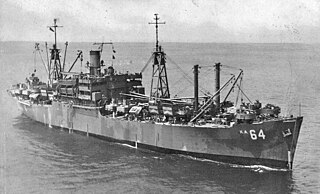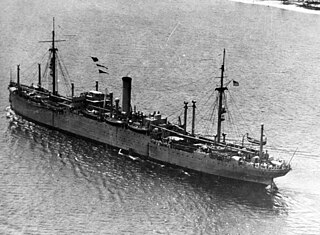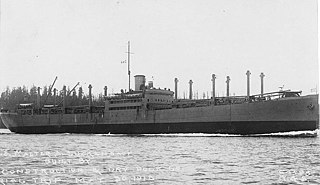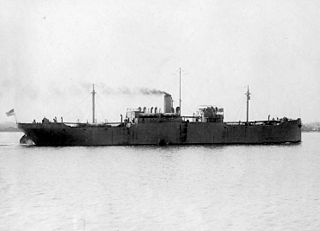USS Sturgeon has been the name of three submarines of the United States Navy:
Four ships of the United States Navy have been named USS or USNS Susquehanna, for the Susquehanna River which rises in Lake Otsego in central New York and flows across Pennsylvania and the northeastern corner of Maryland into the Chesapeake Bay, which is the flooded estuary of that river.
USS Huron may refer to the following ships of the United States Navy:
Four U.S. Navy ships have been named USS Scranton:

USS Waukesha (AKA-84) was a Tolland-class attack cargo ship of the United States Navy named after Waukesha County, Wisconsin. She was designed to carry military cargo and landing craft, and to use the latter to land weapons, supplies, and Marines on enemy shores during amphibious operations. She was later sold, and, under new name of SS Mary Luckenbach, sank a Navy hospital ship after colliding with her out of San Francisco on 25 August 1950.

USS Rappahannock (AF-6) was a Rappahannock-class stores ship acquired by the U.S. Navy for use in World War I. She served in the dangerous North Atlantic Ocean, delivering animals, such as horses and steers on-the-hoof, to American Expeditionary Force troops in Europe.
SS City of Honolulu may refer to one of these Los Angeles Steamship Company ships:

USS Walter A. Luckenbach (ID-3171) was a United States Navy cargo ship and troop transport in commission from 1918 to 1919.
USS Luckenbach may refer to various United States Navy ships:

USS F. J. Luckenbach (ID-2160) was a cargo ship and troop transport that served in the United States Navy from 1918 to 1919. SS F. J. Luckenbach was built as a commercial cargo ship at Quincy, Massachusetts, by Fore River Shipbuilding Corporation for Luckenbach Steamship Company of New York City. Launched on 15 September 1917, she was delivered to Luckenbach on 28 November 1917. She then came under the control of the United States Shipping Board. The Shipping Board transferred her to the U.S. Navy for World War I service on 9 January 1918. Assigned Identification Number 2160, she was commissioned the same day as USS F. J. Luckenbach with Lieutenant Commander W. McLean, USNRF, in command.
USS Frederick Luckenbach was a cargo ship that served in the United States Navy from 1918 to 1919.

USS Julia Luckenbach (ID-1662) was a cargo ship and troop transport that served in the United States Navy from 1918 to 1919.

USS Katrina Luckenbach (ID-3020) was a cargo ship and troop transport that served in the United States Navy from 1918 to 1919.

USS Suwanee (ID-1320) was a United States Navy transport in commission in 1919. She was the second ship to carry her name.
SS Honolulan may refer to one of three cargo ships of the American-Hawaiian Steamship Company:
SS President Grant may refer to:

SS Mary Luckenbach, was a cargo ship of the United States Navy. She was launched in 1918 and completed the following year by the American International Shipbuilding Corp., Hog Island, Pennsylvania as USS Sac City (ID-3861).

USS Radnor (ID-3023) was a cargo ship and later troop transport that served with the United States Navy in 1918–19, during and shortly after World War I. The ship later went into merchant service, and in 1948 under Chinese ownership reportedly became the first all-Chinese ship to visit South America. Radnor was originally ordered as SS War Indian by a private company, but with U.S. entry into World War I in April 1917, she was requisitioned by the U.S. Navy for use as a cargo ship. Commissioned as USS Radnor (ID-3023) in May 1918, the ship spent the remainder of the war transporting cargoes for the Navy. After the war, USS Radnor was converted into a troop transport and used to repatriate U.S. troops home from France.

The SS Harry Luckenbach, built as a cargo ship ordered by the Luckenbach Steamship Company and built at Sun Shipbuilding and Drydock Co. in Chester, Pennsylvania in 1919. The as yet unnamed ship was requisitioned by the United States Shipping Board (USSB) before completion and converted to a troop transport. The USSB allocated the ship, which had been fitted out with temporary troop accommodation in its cargo spaces, to the Navy which commissioned the ship on 7 July 1919 as USS Sol Navis with the Identification number 4031A. The ship was decommissioned October 1919 after two trips to France.

The SS Samoa was a 1,997-ton cargo ship that was able to escape an attack off the coast of California in the early days of World War II. The Samoa was built under a United States Shipping Board (USSB) contract in 1918 as the SS Muerthe, but was launched as the USS Lake Pepin, named after Lake Pepin, by the McDougall Duluth Shipbuilding Company of Duluth, Minnesota measured at 3,600 tons deadweight. She had a triple expansion engine steam engine with 1,250 horsepower (930 kW), a 251-foot (77 m) length, 43.5-foot (13.3 m) beam, a draft of 17 feet 8+1⁄2 inches (5.398 m), a top speed of 9.25 knots. The vessel had a crew of 52, with the hull # 9 and O.N.ID # 21699. The USS Lake Pepin was owned and operated by the United States Navy, commissioned at Montreal, Quebec, Canada on 4 September 1918. For World War I she was fitted with one 3"/50 caliber gun. The Navy put her in Naval Overseas Transportation Service as a coal carrier traveling between the United Kingdom and France as a United States Navy Temporary auxiliary ship. Her coal service ended in May 1919. In June 1919 she returned to the US with a cargo of World War I vehicles and weapons and unused ammunition. The US Navy decommissioned the Lake Pepin on 18 June 1919. In 1923 she was, renamed Samoa purchased and operated by the Hammond Lumber Company. In 1936 she was sold to the Wheeler Logging Company of Portland, Oregon. In February of 1941 she was sold to W. A. Schaefer Company.
This page is based on this
Wikipedia article Text is available under the
CC BY-SA 4.0 license; additional terms may apply.
Images, videos and audio are available under their respective licenses.










